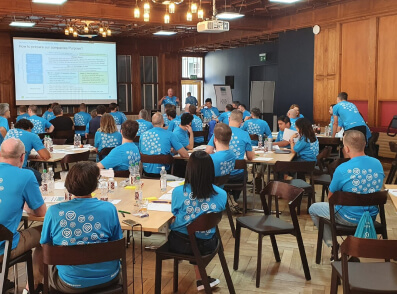Key takeaways
- The healthcare system is shifting from a traditional reactive treatment model to a proactive, preventive approach through improved patient engagement, crucial for managing rising chronic diseases and mental health needs.
- Historically, patient engagement was overlooked due to fragmented tech, low adherence, and a “per-service” payment model. Modern digital platforms address these issues by offering personalized, continuous interaction.
- Digital health engagement platforms (DHEPs) deliver tangible results, including cost reductions (5%+), improved mental health support, better chronic illness management, and increased uptake of preventive care.
- DHEPs provide major benefits for healthcare providers, such as reduced hospital readmissions, higher preventive care adherence, increased efficiency, and improved patient satisfaction.
- Effective digital patient engagement creates a win-win across the entire healthcare ecosystem, leading to fewer insurance claims, better medication adherence for pharmaceutical companies, and improved public health outcomes.
Why patient engagement has been overlooked
Historically, healthcare has largely focused on treatment rather than proactive prevention, with far less emphasis placed on patient behavior as a variable in health outcomes. The sidelining of prevention in healthcare is the result of a number of issues:
- Fragmented technological solutions that limit smooth patient interaction
- Low patient adherence to medical recommendations
- A scarcity of truly personalized engagement tools
Further to this, healthcare has traditionally had a ‘per service’ payment methodology, with value-based care (that focuses on long-term health) being a relatively new arrival.
This neglect of patient engagement has come at a major cost, with estimates suggesting that $100 billion to $290 billion is wasted annually on preventable hospitalizations, missed preventive care, and avoidable complications. Given the mounting burden of chronic diseases (projected to contribute to 84% of global mortality by 2030), a shift in approach is urgently needed.
What engagement means in 2025
Patient engagement has come a long way from simple patient portals and occasional health reminders. It now offers personalized and continual interaction with patients, changing their role from passive recipients of care to active partners in their own health journeys. It’s a new model for patient care that’s being powered by advanced digital health engagement platforms like dacadoo’s Digital Health Engagement Platform (DHEP).
More than just discrete pieces of tech, these platforms offer highly integrated journeys designed to promote fundamental changes in personal health management. Using behavioral science, gamification, and in-depth personalization, DHEP allows healthcare providers to create engaging experiences that motivate patients and deliver genuine health improvements, redefining what’s possible in-patient care.
A quantifiable impact
The idea that patient engagement can drive measurable cost savings is more than just a theory, with independent scientific studies providing compelling evidence to back it up. For instance, research from the University of Groningen has shown that the use of a digital health engagement platform can lead to a reduction in healthcare costs by 5% or more.
Beyond cost savings, digital engagement platforms also deliver tangible improvements in a number of other areas:
Mental health engagement: Digital platforms provide continuous, accessible support for mental well-being, helping individuals to self-manage and engage with their care plans more effectively.
Chronic illness management: For conditions like type 2 diabetes, studies have shown digital disease management can reduce HbA1c levels by one percentage point. Additionally, for acute myocardial infarction (AMI) patients, digital interventions have led to a 50% reduction in 30-day readmission rates.
Preventive care uptake: Digital tools improve the uptake of preventive services through smarter segmentation and dynamic prioritization, allowing for more effective population health management
Quantified health and prioritization: Tools like dacadoo’s Health Score API, which calculates a real-time health score (0-1,000) based on extensive scientific data, allow providers to identify at-risk individuals early and tailor interventions proactively.
The benefits of DHEP for healthcare providers

For healthcare providers on the front lines, digital patient engagement solutions serve as much more than just a “helpful tool”, delivering a host of fundamental operational advantages:
Cost savings through self-management: Even a modest increase in patient engagement can lead to major financial benefits. If just 10% of individuals with chronic diseases actively participate in self-management programs, an estimated $6.6 billion could be saved annually. DHEPs help achieve this by providing accessible tools and support for patients to manage their conditions more effectively.
Increased preventative care uptake: Although widespread insurance exists for most preventive services, adoption rates are remarkably low, with studies revealing that only 8% of US adults actually receive all recommended services. DHEPs, however, can significantly boost these figures by employing intelligent segmentation, dynamic prioritization, tailored nudges, and gamified incentives. These are all designed to spur greater engagement in preventive screenings and healthy lifestyle adjustments.
Improved health literacy: A concerning 88% of US adults don’t have an adequate understanding of how to use the health system or make effective health decisions, with a mere 12% demonstrating proficiency in health literacy. DHEPs bridge this divide by delivering clear, readily available and personalized educational content, encouraging patients to become more involved in their own health management.
Enhanced provider-patient communication: Communication breakdowns are a serious issue in the healthcare system, accounting for an estimated 30% of malpractice claims and costing the industry over $1.7 billion each year. With poor communication during transitions of care, a major culprit behind hospital readmissions, projections indicate that up to 20% could be sidestepped with more explicit discharge instructions and organized follow-up. DHEPs address this issue by providing smooth avenues for communication. Upcoming innovations like the Agentic AI Health Coach (set to arrive later this year) promise to improve the situation even further.
Broader ecosystem benefits
The ripple effects of well-executed digital patient engagement deliver a win-win scenario across the wider healthcare sector.
Health Insurers experience fewer claims due to reduced avoidable care needs and improved chronic disease prevention.
Pharmacies will gain more opportunities to offer drug subscriptions and generate consistent revenue as patient adherence improves.
Policymakers and public health organizations experience improved public health outcomes, a more resilient healthcare system, and a shift towards a truly preventive health model.
Turning strategy into action with dacadoo

Getting patients directly involved in their own healthcare journey may have always been a sound strategy, however, it was one that was hampered by a lack of technology. That’s not the case anymore. Digital infrastructure has matured, with engagement platforms now offering seamless channels for patient support and communication, and AI delivering unprecedented new levels of personalization.
dacadoo’s Digital Health Engagement Platform offers a scientifically validated solution that allows healthcare providers to transform patient care, improve operational efficiency, and manage future healthcare demands more confidently. With our platform integrating smoothly into existing infrastructure, it’s a viable and accessible engagement solution that delivers real-world results.
To find out more about dacadoo and how our DHEP can turn patient engagement into an effective solution for your organization, you can contact us here.





















